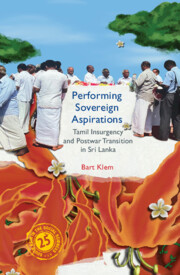Book contents
- Frontmatter
- Dedication
- Contents
- List of Illustrations
- Acknowledgements
- A Typographical Note on Separatism
- List of Abbreviations
- 1 Introduction
- 2 Sovereignty, Performativity and Tamil Nationalism in Sri Lanka
- 3 Performing an Insurgent Sovereign Experiment
- 4 Reconstituting ‘Pure Tamil Space’ after Sovereign Erasure
- 5 The Bureaucratic Evolution of Devolution
- 6 Tamil Nationalist Anti-politics in the Wake of Defeat
- 7 Conclusion
- Epilogue
- Glossary
- References
- Index
4 - Reconstituting ‘Pure Tamil Space’ after Sovereign Erasure
Published online by Cambridge University Press: 30 April 2024
- Frontmatter
- Dedication
- Contents
- List of Illustrations
- Acknowledgements
- A Typographical Note on Separatism
- List of Abbreviations
- 1 Introduction
- 2 Sovereignty, Performativity and Tamil Nationalism in Sri Lanka
- 3 Performing an Insurgent Sovereign Experiment
- 4 Reconstituting ‘Pure Tamil Space’ after Sovereign Erasure
- 5 The Bureaucratic Evolution of Devolution
- 6 Tamil Nationalist Anti-politics in the Wake of Defeat
- 7 Conclusion
- Epilogue
- Glossary
- References
- Index
Summary
The May 2009 defeat of the LTTE was a watershed moment in modern Sri Lankan history. In the final year of intense fighting, the insurgency was gradually pushed back into an ever-smaller swath of the northern Vanni. With hundreds of thousands of civilians trapped between the battle lines, the humanitarian situation became more acute by the day. There was frantic speculation about an LTTE comeback, a final trick or a last-minute international intervention. And then the LTTE sovereign experiment disintegrated. Scores of battered survivors poured out of the last rebel stronghold in Mullivaikal, a sliver of northeastern coastline squashed between the lagoon, the sea and the advancing government forces (see Map 2.1). The remaining LTTE leaders were killed, including, in the final hours, the movement's illustrious commander Prabhakaran. The news of his death, supported by graphic pictures, conveyed the definitive defeat of the LTTE and resounded throughout the global expanse of the Sri Lankan community. This changed everything.
Earlier phases of the war had been defined by violent turning points that left scars of irreversible societal rupture: Black July in 1983, the Eviction in 1990 and the Exodus in 1995. ‘The End’ in 2009 (Seoighe 2017; S. Thiranagama 2013) surpassed these junctures. In terms of historical significance, it arguably even surpassed Sri Lanka's independence, which had after all been a relatively smooth, non-violent recalibration of the sovereign arrangement under the British crown. The 2009 military victory marked the singular sovereign assertion of the Sri Lankan government. It elevated President Rajapaksa to the level of a mythical and unquestionable father of the nation, at least initially. And it marked the perishing of LTTE sovereignty, voiding its moral and legal referents – acts committed in its name had now become baseless.
The pictures of Prabhakaran's corpse did not just display a fallen military commander. They showed the slain embodiment of the LTTE struggle, revered like a divine figure and the ultimate referent of the movement's sovereign power. His death had profound consequences for the Tamil nationalist movement at large. The collective trauma of the wholesale killing of civilians in the run-up to the LTTE defeat, widely considered genocide in Tamil circles, left deep imprints in Tamil political consciousness.
- Type
- Chapter
- Information
- Performing Sovereign AspirationsTamil Insurgency and Postwar Transition in Sri Lanka, pp. 77 - 99Publisher: Cambridge University PressPrint publication year: 2024
- Creative Commons
- This content is Open Access and distributed under the terms of the Creative Commons Attribution licence CC-BY-NC 4.0 https://creativecommons.org/cclicenses/

